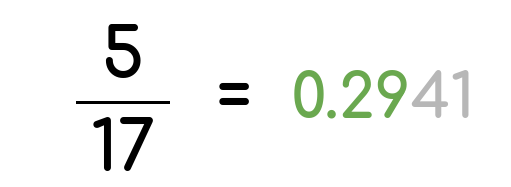Rounding Fractions calculator
Learn how to round even complex fractions using various approximation methods

Welcome! This friendly rounding fractions calculator is like a math super-helper: it doesn’t only round fractions to the nearest whole number — it can also round to different decimal precisions when you need more detail.
Just type a fraction’s numerator and denominator, choose how you want to round, and click “calculate.” Boom — clear results you can use in homework, science projects, or everyday number puzzles. If you ever forget what a fraction is, check the overview on Wikipedia.
Want to understand the why behind the answer (and impress your teacher)? Let’s learn the idea step by step with quick examples you already have in class.
How to Round Fractions?
There are a whole lot of ways to round numbers, including ceiling, floor, half-up, and half-down. That said, the half-up method is the most widely used in school.
Here’s how this rounding method works:
- Convert the fraction to a decimal.
- Check the value of the first decimal place.
- If it’s lower than 5, ignore it and everything that’s on its right.
- If it’s higher than or equal to 5, add 1 to the digit on the left and remove everything else (including the rounded decimal.)
Now let’s try it with the same examples you saw above.
Suppose the fraction you’re working with is 23/5. If you divide the numerator by the denominator, you’ll get 4.6. According to the half-up method, you can round that 4.6 to 5 since 6 is higher than the half-point.
Similarly, if you’re working with 23/7, you’ll get 3.28571428571. Now, that’s a long decimal! But the rule is the same: since the first decimal is 2 (which is less than 5), 23/7 rounds to 3.
What about exactly in the middle — 23/2 = 11.5? With half-up rounding, you still go to the nearest neighbor on the higher side: 12.
Changing the Precision
In the examples above, we rounded to the nearest integer. But you can choose a different precision from the following options:
- Thousandth (rounding to 3 decimals)
- Hundredth (rounding to 2 decimals)
- Tenth (rounding to 1 decimal)
- Integer
- Tens
- Hundreds
- Thousands
- Millions
- Billions
Take 23/7 again. Earlier we rounded it to 3 from 3.28571428571 because we chose integers. If you round to the tenth, the calculator checks the second decimal (it’s 8), so it becomes 3.3.
If you choose the hundredth, the third decimal is 5, so the second decimal bumps up: 23/7 → 3.29.
Pro tip: the CalcoPolis fraction rounding calculator is set to a precision of the hundredth by default. If you need whole numbers (or any other level), change the “round to” dropdown first — just like a video-game setting!
Rounding Negative Fractions
Negative numbers can feel tricky — but a number line picture helps. With half-up rounding, we still follow the same rules relative to the nearest neighbors.
Some people might think to move negative numbers toward zero. For example, they might round −23/2 = −11.5 to −11. But with the half-up rule used here, you go to the “higher” neighbor in the rounding sense for halves — which means down the number line for negatives — so −23/2 rounds to −12. That’s exactly what the CalcoPolis calculator returns.
Role of Rounding Fractions in Education

Rounding fractions is a power-up for young mathematicians. It makes long decimals shorter, helps you estimate quickly, and keeps your work neat when exact values aren’t needed. You’ll use it in science labs, money math, and even coding projects!
- Nearest hundredth: great for measurements and money where two decimals matter.
- Nearest whole: perfect for fast estimates in word problems and mental math.
- Calculator confidence: Use the rounding tool to check your hand work and see how changing the precision changes the answer.
The more you practice rounding, the better you get at sense-checking answers — a super skill for quizzes and real life.
Other helpful tools
You can find many more helpful tools here at Calcopolis. For rounding money amounts, we recommend you to visit the rounding money amounts calculator.
If you wish to convert fractions to a simpler form, you may use our fraction simplifier calculator. The tool will give you fractions instead of rounded decimals.
For a complex fraction, you may use the mixed number to a decimal converter to reduce the mixed number to a simple fraction. Alternatively, you can convert a fraction to a percentage value.
Keep exploring — every fraction you round builds your number sense, and that makes all of math easier (and more fun)!

